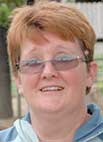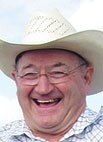
Laura Alms might well be called a “horse dancer.”
In the arena, she is one with the horse she rides. With gentle nudges, infinitesimal shifts of weight and silent direction, she leads her equine partner in graceful choreography. They glide and turn in perfect harmony around their equestrian ballroom.
Since 1981, Laura has been training in the art of dressage, a discipline that develops a horse’s natural athletic and performance abilities and teaches it to respond smoothly — and seemingly effortlessly — to a rider’s slightest command. Often called “horse ballet,” dressage requires strict attention to detail and precise execution — from the rider as well as the horse.
“Dressage really makes you work,” Laura said. “You use all you body parts at once, but they need to work independently of each other. It’s a mental challenge, too.
“The amazing thing is that when you do it right, the horse does, too,” Laura said.
Although dressage is somewhat unusual for the Midwest, it is the focus of Taura Farms, the acreage Laura and her husband, Tom, own and operate in Lawrence County, just east of Mt. Vernon, Mo. Not only does Laura continue to develop her own riding skills on the farm, it also is a training ground for students — youngsters and adults, human and equine, a breeding farm and a marketplace for the warmbloods best suited to dressage. In addition, the farm provides boarding and at-show coaching.
All breeds of horses are suitable for dressage, but Taura Farms specializes in bloodlines from Germany and Holland. The ideal horse for dressage, Laura said, stands 15.3 to 16.1 hands high, weighs 1,000 to 1,200 pounds and has large feet, long hip joints and big joints to handle the concussion from jumps required in competition. Disposition and trainability are important, too. In choosing show animals, Laura looks for those who learn quickly and have extrovert personalities.
“We like them to like people,” she said. “We have some real snuggle bunnies.”
A little cockiness doesn’t hurt, either. The horse that loves to perform will hold its head a little higher, be little flashier — and win the judges’ hearts.
At any one time, the farm houses about 30 horses at all levels, from stock to beginners to upper Grand Prix level. Training doesn’t begin until a horse is about three years old because the warmbloods are larger and growth plates take longer to solidify; starting training too soon can cause injuries. The training day starts at 8:30 a.m. and includes a 45-minute session for each horse. Proper training takes a year, but warmbloods can have long careers in the show ring, being strong competitors into their late teens and 20s.
Currently, Laura has four in her training stable, and seven are under the instruction of Claudia Springer-Misner, a certified U.S. Dressage Federation trainer. Claudia also continues to coach Laura, who maintains that even experienced riders need refresher courses to “keep us up to snuff.”
“You’re always training,” Laura said. “You are constantly setting goals, and when you reach those, you set new ones. The real goal is to keep moving up."







